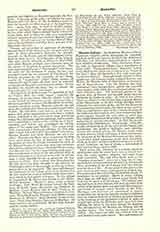

Mazatec Indians.—An important Mexican tribe of Zapotecan linguistic stock, occupying the mountain region of northeast Oaxaca, chiefly in the districts of Cuicatlan and Teotitlan, and estimated to number from 18,000 to 20,000 souls. Their chief town, Huan-tla, with its dependent villages, has a population of about 7,000. Their popular name “Mazateca” is that given them by the Aztec and is said to mean “Lords of the Deer”; they call themselves A-a, with nasal pronunciation (Bauer). Although closely related to their neighbors, the formerly highly cultured Zapotec and Mixtec, the Mazatec were of ruder habit, as became a race of mountaineers. Like the Zapotec also they maintained their independence against the powerful Aztec empire, with which they maintained almost constant defensive war. The principal portion of the present state of Oaxaca was brought under Spanish dominion by Cortes in 1521. In 1535 it was established as a diocese, with Father Juan Lopez de Barate of the Dominicans, as its first bishop, through whose influence the conversion of the natives was entrusted to missionaries of that order, by whom it was success-fully accomplished in spite of the extreme devotion of the Indians to their ancient rites, even to secreting their sacred images beneath the very altar in order that they might unsuspected do reverence to the one while appearing to venerate the other. In 1575 the Jesuits reinforced the Dominicans. Even today, while outwardly conforming to all the rules of the Church and manifesting the greatest deference and affection toward the resident priests, the Mazatec retain most of their ancient beliefs and many of their ceremonies. By tolerance of the Mexican Government they maintained their tribal autonomy under their hereditary chiefs up to 1857, as also a professional keeper of their sacred traditions, the last of whom, a descendant of their ancient kings, died in 1869.
Their native cult, still kept up to a large extent in combination with the newer rites, was an animal worship, the snake, panther, alligator, and eagle being most venerated. The soul after death went to the “kingdom of animals”, where for a long time it wandered about, being assisted or attacked by the animals there, according as the dead person had been kind or cruel to them in life. At one point in the journey the soul was assisted across a wide stream by a black dog. It seems to have been held that the soul was finally reincarnated in an animal. Hence in many villages black dogs are still kept in almost every family and buried in the grave with the owner. The ancient sowing and harvest rites also are still kept up, with invocation of the animal gods and spirits of the mountain, and burial of curious sacred bundles in the fields. Marriages and baptisms are solemnized in regular church form by the priest, but the baptism is followed later by a house festival, of which a principal feature is the washing of the godfather’s hands in order to cleanse him of the sin which has come upon him from holding the infant in his arms during the baptism. The occupations of the Mazatec are farming and the simpler trades. The women are expert weavers of cotton. The houses are light huts daubed with clay and thatched with palm leaves. Men and women are fully dressed, the women being picturesque in shawls and gowns of their own weaving, decorated with ribbons and worked with human and animal figures, particularly that of the eagle. They have still their own calendar of thirteen months, with days bearing animal names. The second volume of Pimentel’s “Cuadro” contains a sketch of the language. See also Zapoteca Indians.
JAMES MOONEY

